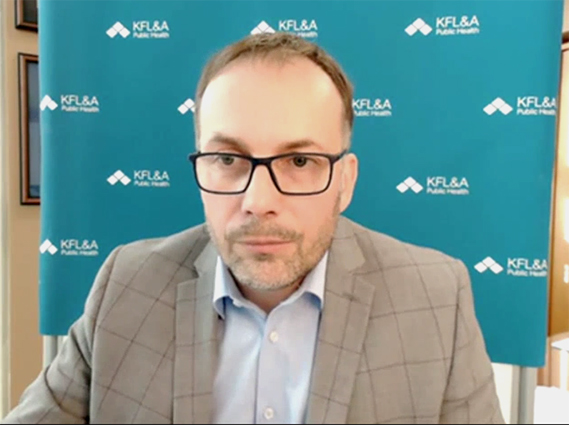Adam Prudhomme
Editor
KFLA Public Health set yet another troubling COVID-19 record on Thursday with 198 new cases reported to bring the active case count in the region up to 1,272.
Speaking with local media via Skype on Thursday, KFLA Public Health medical officer of health Dr. Piotr Oglaza noted the increase is a direct result of the Omicron variant. As of today there are now six confirmed cases of the latest variant of concern in the region with over 500 more suspected cases.
“Unfortunately when you look at how we compare to the rest of the country and the rest of the province, we are the highest in the country and the highest ever case rate ever reported by any Public Health unit over the course of this pandemic and that number is 475 per 100,000,” Oglaza said of the region’s case count. “Our active case rate is more than double that of any other Public Health unit in this province and that is really a true impact of the Omicron variant as it started spread in this region and is now on track to being the dominant strain of COVID-19.”
In the last week about 4.2 per cent of the KFLA population has been tested for COVID-19.
“We are currently at 475 (cases) per 100,000 (people) which is unfortunately a new peak for us and we’ve been setting these new peaks almost on a daily basis,” said Oglaza. “This represents really a significant Omicron variant activity in this region. Our per cent positivity is now up to 7.1 per cent, which is again a new record, a new high per cent positivity in this region. This number has more than doubled in less than one week from 4.2 per cent.”
Over half of Thursday’s cases, 108 to be exact, were of the 18-29 age bracket.
“For the last 30 days the rate of the unvaccinated population is now approximately two times higher than the rate of the vaccinated population, but that’s again an impact of Omicron which is now demonstrating a significant vaccine escape,” said Oglaza. “But what we see so far is that it is still the two doses of vaccine provide protection against severe disease. One caveat to that is the spread that we’ve seen so far is it is predominantly in the younger population, so almost two third of the cases of Omicron are among the population of 18-29 and then the additional 26 per cent are in the population of 29-40. This is really at this point mainly spread occurring among the younger demographic, people less likely to be severely sick.”
When asked why the virus seems to be limited mostly to the 18-29 age group, Oglaza pointed to social gatherings.
“The main reason that we see that initial spread occurring in the younger population is just a matter of how potentially that the initial cases have spread,” he said. “There was an outbreak or spread among the population of this age linked to the type of social interaction that individuals in this age group typically engage in. When we see congregation of a large number of people in a social setting with limited physical distancing, that really was the perfect storm for Omicron.”
With third dose vaccine eligibility set to open to anyone 18 or older and three months removed from their second shot on Monday, Oglaza urged people to sign up for the booster jab.
“Three doses provide much better protection, approximately 75 per cent vaccine effectiveness for three, which is less than what we had against Delta with two doses, but it’s still the protection that could make the big difference on the population level,” said Oglaza. “With this expanded eligibility for the third dose now, anyone 18 years or older, and shortened interval between the completion of the full dose to three months, 84 days, I urge everyone that is eligible and have received two doses to book their appointment for the third dose as soon as possible.”
Currently there are 25 people in local hospital due to COVID-19, each one linked to the Delta variant. Oglaza said there is evidence the Delta has plateaued as now Omicron moves in.
When asked why the Kingston region has been hit so hard, Oglaza suggested it’s likely that this region is just an example of what is coming to the rest of Ontario.
“It’s likely a combination of some unfortunate set of circumstances that have led to the initial transmission and some of the outbreaks that we may have seen among the younger demographic,” said Oglaza. “We are unfortunately probably not that far ahead of other areas and unfortunately if there’s any lessons from how quickly Omicron spreads once introduced into the population is something that sadly we are going to see in other parts of the province and other jurisdictions. That’s something my colleagues from Public Health are looking at very seriously when determining what other measures need to be implemented for that unfortunate set of circumstances.”
When asked if he would recommend schools move to online following the holiday break, Oglaza said as of right now there would be no need.
“What we’ve seen so far in our schools is that school age children are not driving the spread,” he said. “Our cases in the school system are a reflection of really high COVID-19 activity in this community. They’re not driving it, they are the victim of it. In this scenario I have full commitment and support for continuing in-person school for as long as possible for as long as operationally possible. As many of my colleagues have mentioned many times, schools will be the absolute sector to close.”

